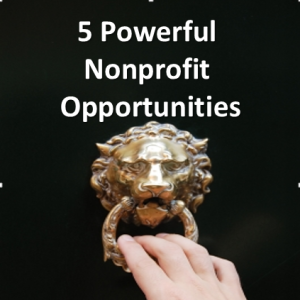Your year-long “Dive the Five” virtual course begins!
Listen.
Hear the knocking?
I most surely do!
If you pay attention, you’ll see the year ahead is bursting with opportunities for your nonprofit to succeed — more than you’ve ever succeeded before.
What do you need to do to grab these opportunities?
It’s as simple as
- answering the knock on the door;
- welcoming your guests inside, and
- getting to know them so well they become like family.
I’ve selected the top 5 ‘guests’ you should welcome into your nonprofit this year. I want you to make them part of your family. Or think of them as the top 5 ‘dives’ you must master in 2016. If you already have some of them down, you’re ahead of the game. But I’ll bet you a donation to your nonprofit that you could do them a lot better!
 Dive the Five
Dive the Five
Learn them. Live them. Love them.
Within a reasonable period, if you embrace these five “dives” with intent, dedication and passion, doing them will begin to feel as natural and liberating as breathing. I mean it. These are your five opportunities to free up your nonprofit to survive and thrive in a world that’s evolving at a rapid pace. A world where some things don’t change too much, and others change a lot.
I believe strongly that if you master these five things you’ll succeed beyond your wildest dreams.
The kicker? It won’t happen without commitment and hard work.
“Unless commitment is made, there are only promises and hopes… but no plans.” – Peter Drucker
My goal in the year ahead is to persuade you to open the door to these five opportunities. To help you commit to learning. To help you work hard at living your commitments and practicing strategies that work. To help you work smart and get used to loving the results of your newly re-energized labors. To help you get “10s” on all of your dives and truly go for the gold this year!
Smart Nonprofits and Fundraisers Must ‘Dive the Five’ in 2016:
- Master one-to-one major gift fundraising.
- Master donor retention.
- Integrate donor-centered fundraising with a social content marketing strategy.
- Master online social fundraising.
- Shift to an organization-wide culture of philanthropy.
Today, I want to briefly introduce each of these five core strategies — in no particular order — and suggest why they should shape your work plans for the coming year.
Over the course of the coming months I will discuss each of these areas in great detail. We’ll jump around a bit so neither of us gets bored. Life is not neat and sometimes you’ve got to do all five of these things simultaneously. So I won’t pretend you can focus just on major gifts and ignore online fundraising. And I won’t beat you over the head with a single strategy until you’re sick of it. I’ll try to mix things up and keep it fun. Because fundraising should be fun — for you, and for your donors.
Write these 5 themes down. Put them on a sticky note next to your computer. Then we’ll explore the key ways you must commit to actually making this happen!
Make these Strategies Your Priorities
- Don’t allow other stuff to distract you and take over. It’s too easy to allow the “urgent” to get in the way of the “important.” If you do, you’ll raise some money and bring in some donors – but you won’t build enough support, nor will you build sustainable support. I’m urging you to focus on the foundational stuff this year — the things that will make you strong and proactive, not just reactive. It will be easy to stray off the path. You’ll work very hard, I’ve little doubt. But you won’t work smart.
- Eschew short-term wins that will inhibit long-term gains. The base of supporters you need are the folks who will stick with you over the long-run and help your organization survive and thrive. Not just today, but for many tomorrows. “Every little gift helps” is not a long-term fundraising strategy. Every strategy should be enacted within the context of a larger plan — one with a clearly thought-out destination. Otherwise, you’ll burn out. You won’t feel successful. You won’t enjoy the journey. Your donors won’t enjoy the journey. You’ll plod along on a slow-moving hamster wheel, pointlessly going round and round but never really getting anywhere new.
- It would be a shame to just keep on as before, without a strategic fundraising and marketing management plan.
By the way, I’m going to use a lot of wisdom from my favorite management guru, Peter Drucker. I highly recommend just about any of his books, especially Managing the Nonprofit Organization. I also love my copy of “The Daily Drucker” which has an inspiring quote for every day of the year. It never fails me! The quote for February 1st happens to be titled “Crossing the divide into the new realities” and could not be more apropos:
“Every few hundred years there occurs a sharp transformation. We cross a “divide… ACTION POINT: Next time you hear colleagues pounding the table for something that is clearly yesterday’s news, find a way to tell them they need to wake up and smell the coffee.” – Peter Drucker
Okay, ready to smell the coffee, see where you need to go this year and begin the transformation?
Let’s begin with the most traditional, tried-and-true strategy:
Master One-To-One Major Gift Fundraising
I hope this one isn’t controversial for you. 80% of the money in the U.S., according to Giving USA, comes from individuals. And of these donors, 12% account for the lion’s share of the money raised – 88%!
If you don’t have a robust strategy to go after the single largest source of philanthropy that exists — by far — then I’m going to suggest you make this the year to do so. It’s also the most cost-effective way to raise funds, and will take much less time than something like putting together a special event. If you’ve got leaders who are constantly suggesting events as your “big money” fundraisers, you need to learn how to rebut their arguments and show them there’s a better way. One that won’t lead to burn out. One that won’t lead to spending almost as much as you net. One that won’t lead to donors who never give again.
Welcome major gift fundraising to your family!
Next, the strategy without which nothing else makes a difference:
Master Donor Retention
This is perhaps the topic about which I’m most passionate. I just hate to see nonprofits wasting their limited resources running on a treadmill. We’re all about the work ethic in this country. We need to shift to a “work smart” ethic.
Whenever I speak to nonprofits about how pathetic the average donor retention rate is, they share my dismay. Then when I explain how to overcome this problem, inevitably I’m met with “Well, that’s just common sense.”
As if common sense means it’s not worth doing.
People… just do it! Be nice. Don’t be rude. Thank people promptly, personally and with feeling. Act on your common sense. I promise, you’ll end up keeping and upgrading a lot more donors.
Recently a colleague of mine, Michael Rosen, asked me why I thought nonprofits didn’t ‘just do it.’ Here is my reply:
I think it may be because the “powers that be” don’t reward staff for donor retention the way they reward them for bringing in new gifts. Folks would rather hear, “We gained 100 new donors this year” (never mind the 104 donors we lost) than, “We retained 10% more donors this year.” I liken it to shopping for new clothes. We enjoy the hunt, and the newness of our “finds” and stuff the old, already acquired stuff (donors; clothing) deep into the corners (of databases; closets) where we neglect them terribly. We need to rediscover the art of getting to know folks better; then discovering how much added joy that can bring.
If you’re not making donor retention your top priority, you’re working like a hamster on a wheel — feverishly running, running, running; yet never making progress. The data is clear. It’s been clear for a long while now. Take the Nike pledge: JUST DO IT!
Welcome a robust donor retention strategy to your family!
Onto the heart and soul of successful fundraising in 2016:
Integrate Donor-Centered Fundraising with a Social Content Marketing Strategy
Let’s begin with the first part of this two-part equation: “Integrate. Donor-centered. Fundraising.”
This part is directly related to shifting to an organization-wide donor-centered culture.
And every word is intentional and impactful.
Integrate: Bring together.
Donor-centered: Focus on your constituent.
Fundraising: We’re all in fundraising now.
The core of what I’ll be talking about with this strategy is “content marketing.” It’s a meme du jour. And, as with most memes, there’s a reason for it. But you’ve got to come at it from an integrated, donor-centered place or the content will fall on deaf ears. It will be a lead balloon.
So it’s worth spending a bit of time this year talking about what it means to create integrated, donor-centered content that is consistent across your entire organization. Because your donor only knows one organization. They don’t care which department the content comes from.
Welcome integrated content marketing to your family!

5 Powerful Nonprofit Opportunities: Your Path to Success in 2016. Hint: You’ve got to get social and go where others are going, or you’ll miss out!
Why and what you’ll need to do to
Master Online Social Fundraising
“The purpose of a business is to create a customer.” – Peter Drucker
“The purpose of a business is to create a customer who creates customers.” – Shiv Singh
“We now accept the fact that learning is a lifelong process of keeping abreast of change. And the most pressing task is to teach people how to learn.” – Peter Drucker
To get a taste of what I’ll be teaching you this year, take a listen to this podcast on “Mastering Online Social Fundraising” on “Driving Participation” with Beth Brodovsky. I discuss how to target key influencers on social media; Delegating media sharing throughout your organization; Creating and maintaining a marketing editorial calendar, and developing a culture of philanthropy.
Welcome online social fundraising to your family!
Why and what you’ll need to do to
Shift to an Organization-Wide Donor-Centered Culture
Sometimes you’ve got to get into the pool and swim with your donors. You’ve got to see things from their perspective. Feel what they feel. It’s the only way to succeed with donor centricity, integrated content marketing, creating a community of supporters who share your values and getting everyone on the same page. You can’t integrate content and strategies until you integrate departments and people.
Some folks call this donor-centered integration a “gratitude culture,” a “culture of philanthropy,” or a “customer service” culture. We’ll explore each of these notions, and learn why they’re all relevant. Your organizational culture should fairly burst with gratitude, philanthropy and service.
Welcome an embracing culture of philanthropy to your family!
TODAY’S TAKE-AWAYS:
For each of these five strategic areas, you must commit to:
- Educate yourself and your team; understand these core principles, backwards and forwards.
- Perfect your skills and the skills of your team.
- Create and implement detailed written plans and timelines for each of these strategies.
- Get your entire organization and constituency on board to help you; you’re a philanthropy team!
This is the year I’m committed to help you do all these things. Strategically. Consistently. And within an integrated plan that assures all your hard work will mean something. Strategy #1 will connect to strategy #2; then #3, #4 and #5. No more doing stuff, and then asking “Now what?” Or even worse, “So what?”
All you have to do for now is:
- Continue as a Clairification subscriber
- Open your articles when you receive them
- Make note of the “Take-Aways,” “Action Tips,” and “To-Do’s” in each article
- Write down a plan to actually make use of the action items suggested
- Operationalize your plan by creating a timeline, assigning resources and managing responsibilities
- Email me if you have questions or come up against insurmountable challenges
You might also want to save the articles in a file. By the time we’re done you’ll have a virtual “fundraising bible.” But that’s up to you.
I’ll be back soon and we’ll begin to really dig in!
This article is part of a series that will form the architecture for Clairification’s virtual online curriculum this year – 5 Things Nonprofits and Fundraisers Must Do to Succeed in 2016:
- Master one-to-one major gift fundraising,
- Master donor retention,
- Integrate donor-centered fundraising with a robust content marketing strategy
- Master online social fundraising, and
- Shift to an organization-wide donor-centered culture of philanthropy.
Title image courtesy of Freedigitalphotos.net; Other photos via photpin: Leaping Legends (license), David Boudia – USA (license), Luderick (license), Breakfast picnic (license), Anemone Fish (license), Scuba diver looking at the “Christ of the Abyss” bronze sculpture at John Pennekamp Coral Reef State Park: Key Largo, Florida (license), School of Fish (license), Somewhere, beneath the sea (license).













Claire – I really love this focus on these 5 high priority areas for the year. It already makes me feel more organized and focused in my own approach – thank you! I’m very excited about following your lead on this and digging in really deep on these 5 areas. It’s also helping me set my own objectives for the calendar year. I’ve been asking myself: how will I know in December that I really moved the needed on something important for our organization? Well, now you’ve given me the framework that is the answer to that question! Thank you!
You are most welcome Julia. And we’re just getting started!